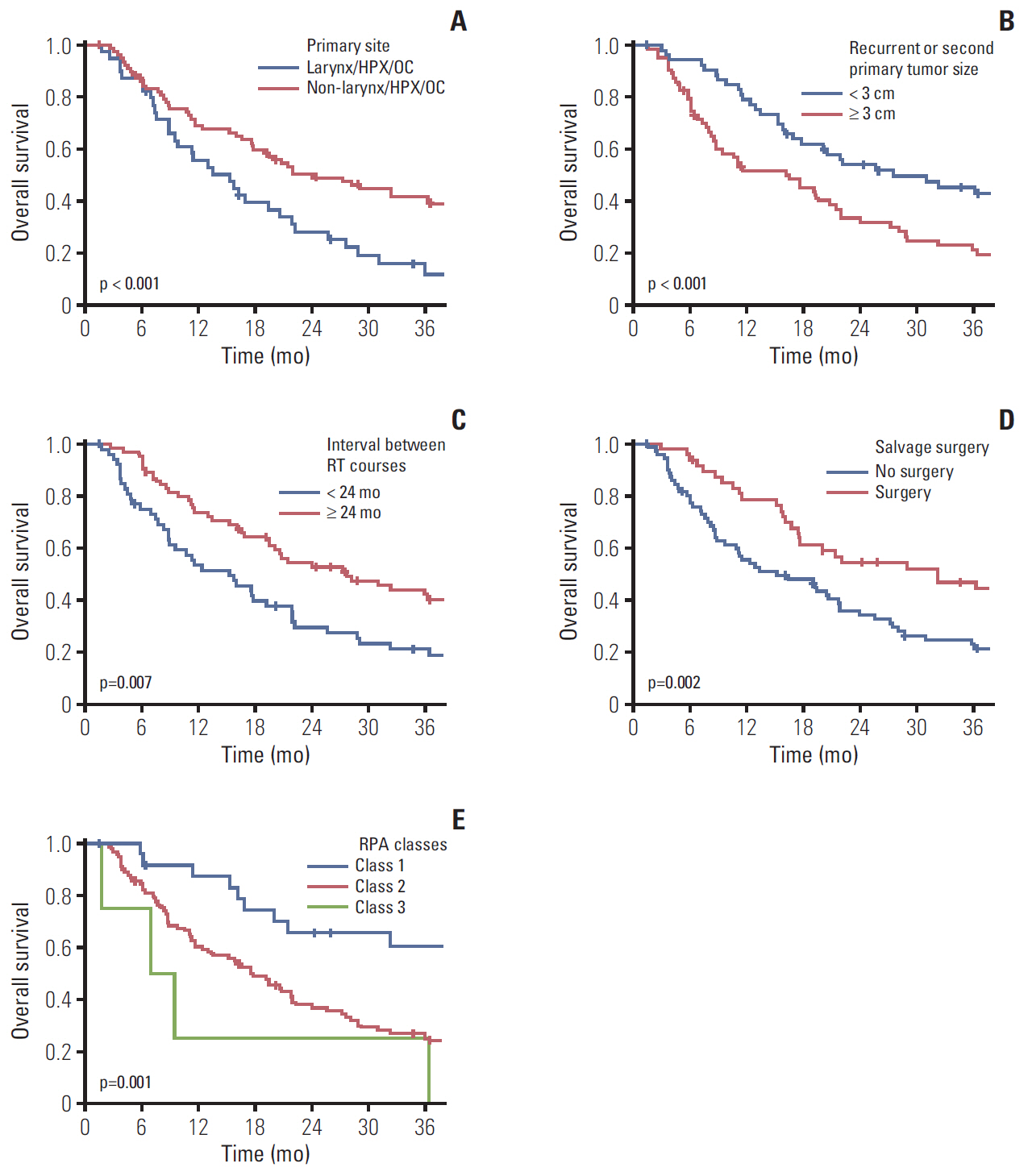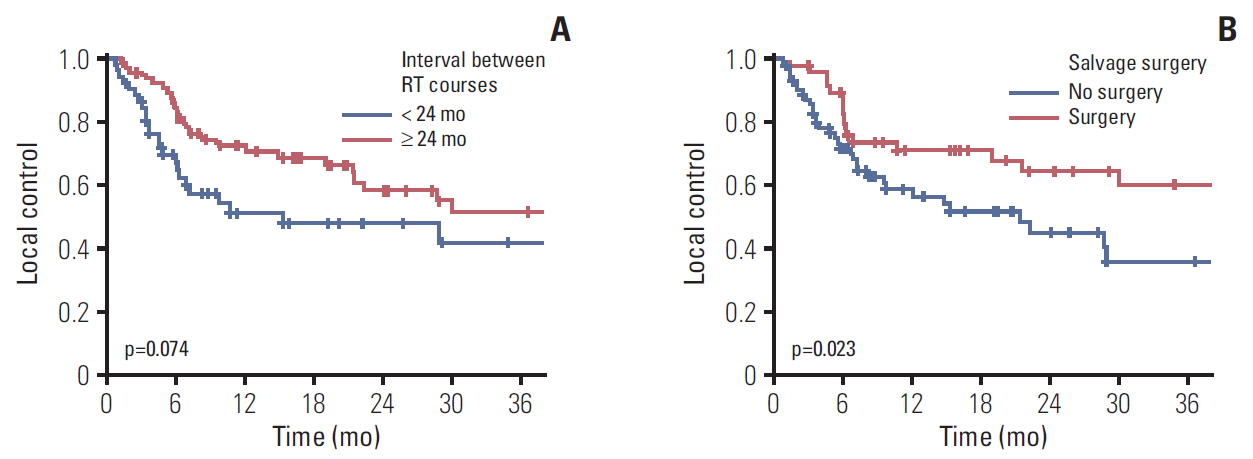Cancer Res Treat.
2020 Oct;52(4):1031-1040. 10.4143/crt.2020.310.
Intensity-Modulated Radiotherapy-Based Reirradiation for Head and Neck Cancer: A Multi-institutional Study by Korean Radiation Oncology Group (KROG 1707)
- Affiliations
-
- 1Department of Radiation Oncology, Inha University Hospital, Inha University College of Medicine, Incheon, Korea
- 2Department of Radiation Oncology, Yonsei University College of Medicine, Seoul, Korea
- 3Department of Radiation Oncology, St. Mary's Hospital, College of Medicine, The Catholic University of Korea, Seoul, Korea
- 4Department of Radiation Oncology, Incheon St. Mary's Hospital, College of Medicine, The Catholic University of Korea, Seoul, Korea
- 5Department of Radiation Oncology, Yeungnam University Medical Center, Yeungnam University College of Medicine, Daegu, Korea
- 6Department of Radiation Oncology, Wonju Severance Christian Hospital, Yonsei University Wonju College of Medicine, Wonju, Korea
- 7Department of Radiation Oncology, Gachon University Gil Medical Center, Incheon, Korea
- KMID: 2507930
- DOI: http://doi.org/10.4143/crt.2020.310
Abstract
- Purpose
The benefits of reirradiation for head and neck cancer (HNC) have not been determined. This study evaluated the efficacy of reirradiation using intensity-modulated radiotherapy (IMRT) for recurrent or second primary HNC (RSPHNC) and identified subgroups for whom reirradiation for RSPHNC is beneficial.
Materials and Methods
A total of 118 patients from seven Korean institutions with RSPHNC who underwent IMRT-based reirradiation between 2006 and 2015 were evaluated through retrospective review of medical records. We assessed overall survival (OS) and local control (LC) within the radiotherapy (RT) field following IMRT-based reirradiation. Additionally, the OS curve according to the recursive partitioning analysis (RPA) suggested by the Multi-Institution Reirradiation (MIRI) Collaborative was determined.
Results
At a median follow-up period of 18.5 months, OS at 2 years was 43.1%. In multivariate analysis, primary subsite, recurrent tumor size, interval between RT courses, and salvage surgery were associated with OS. With regard to the MIRI RPA model, the class I subgroup had a significantly higher OS than class II or III subgroups. LC at 2 years was 53.5%. Multivariate analyses revealed that both intervals between RT courses and salvage surgery were prognostic factors affecting LC. Grade 3 or more toxicity and grade 5 toxicity rates were 8.5% and 0.8%, respectively.
Conclusion
IMRT-based reirradiation was an effective therapeutic option for patients with RSPHNC, especially those with resectable tumors and a long interval between RT courses. Further, our patients' population validated the MIRI RPA classification by showing the difference of OS according to MIRI RPA class.
Figure
Reference
-
References
1. Chao KS, Ozyigit G, Tran BN, Cengiz M, Dempsey JF, Low DA. Patterns of failure in patients receiving definitive and postoperative IMRT for head-and-neck cancer. Int J Radiat Oncol Biol Phys. 2003; 55:312–21.
Article2. Ang KK, Zhang Q, Rosenthal DI, Nguyen-Tan PF, Sherman EJ, Weber RS, et al. Randomized phase III trial of concurrent accelerated radiation plus cisplatin with or without cetuximab for stage III to IV head and neck carcinoma: RTOG 0522. J Clin Oncol. 2014; 32:2940–50.
Article3. Beitler JJ, Zhang Q, Fu KK, Trotti A, Spencer SA, Jones CU, et al. Final results of local-regional control and late toxicity of RTOG 9003: a randomized trial of altered fractionation radiation for locally advanced head and neck cancer. Int J Radiat Oncol Biol Phys. 2014; 89:13–20.
Article4. Wong LY, Wei WI, Lam LK, Yuen AP. Salvage of recurrent head and neck squamous cell carcinoma after primary curative surgery. Head Neck. 2003; 25:953–9.
Article5. Goodwin WJ Jr. Salvage surgery for patients with recurrent squamous cell carcinoma of the upper aerodigestive tract: when do the ends justify the means? Laryngoscope. 2000; 110:1–18.
Article6. Cacicedo J, Navarro A, Alongi F, Gomez de Iturriaga A, Del Hoyo O, Boveda E, et al. The role of re-irradiation of secondary and recurrent head and neck carcinomas: is it a potentially curative treatment? A practical approach. Cancer Treat Rev. 2014; 40:178–89.
Article7. Intensity Modulated Radiation Therapy Collaborative Working Group. Intensity-modulated radiotherapy: current status and issues of interest. Int J Radiat Oncol Biol Phys. 2001; 51:880–914.8. Puri DR, Chou W, Lee N. Intensity-modulated radiation therapy in head and neck cancers: dosimetric advantages and update of clinical results. Am J Clin Oncol. 2005; 28:415–23.9. Lee N, Puri DR, Blanco AI, Chao KS. Intensity-modulated radiation therapy in head and neck cancers: an update. Head Neck. 2007; 29:387–400.
Article10. Ho JC, Phan J. Reirradiation of head and neck cancer using modern highly conformal techniques. Head Neck. 2018; 40:2078–93.
Article11. Chen AM, Phillips TL, Lee NY. Practical considerations in the re-irradiation of recurrent and second primary head-and-neck cancer: who, why, how, and how much? Int J Radiat Oncol Biol Phys. 2011; 81:1211–9.
Article12. Kim YS. Reirradiation of head and neck cancer in the era of intensity-modulated radiotherapy: patient selection, practical aspects, and current evidence. Radiat Oncol J. 2017; 35:1–15.
Article13. Ward MC, Riaz N, Caudell JJ, Dunlap NE, Isrow D, Zakem SJ, et al. Refining patient selection for reirradiation of head and neck squamous carcinoma in the IMRT era: a multi-institution cohort study by the MIRI collaborative. Int J Radiat Oncol Biol Phys. 2018; 100:586–94.
Article14. Toledano I, Graff P, Serre A, Boisselier P, Bensadoun RJ, Ortholan C, et al. Intensity-modulated radiotherapy in head and neck cancer: results of the prospective study GORTEC 2004-03. Radiother Oncol. 2012; 103:57–62.
Article15. Zhang B, Mo Z, Du W, Wang Y, Liu L, Wei Y. Intensity-modulated radiation therapy versus 2D-RT or 3D-CRT for the treatment of nasopharyngeal carcinoma: a systematic review and meta-analysis. Oral Oncol. 2015; 51:1041–6.
Article16. Spencer SA, Harris J, Wheeler RH, Machtay M, Schultz C, Spanos W, et al. Final report of RTOG 9610, a multi-institutional trial of reirradiation and chemotherapy for unresectable recurrent squamous cell carcinoma of the head and neck. Head Neck. 2008; 30:281–8.
Article17. Langer CJ, Harris J, Horwitz EM, Nicolaou N, Kies M, Curran W, et al. Phase II study of low-dose paclitaxel and cisplatin in combination with split-course concomitant twice-daily reirradiation in recurrent squamous cell carcinoma of the head and neck: results of Radiation Therapy Oncology Group Protocol 9911. J Clin Oncol. 2007; 25:4800–5.
Article18. Orlandi E, Bonomo P, Ferella L, D’Angelo E, Maddalo M, Alterio D, et al. Long-term outcome of re-irradiation for recurrent or second primary head and neck cancer: a multi-institutional study of AIRO-Head and Neck working group. Head Neck. 2019; 41:3684–92.
Article19. Riaz N, Hong JC, Sherman EJ, Morris L, Fury M, Ganly I, et al. A nomogram to predict loco-regional control after re-irradiation for head and neck cancer. Radiother Oncol. 2014; 111:382–7.
Article20. Weichselbaum RR, Beckett MA, Schwartz JL, Dritschilo A. Radioresistant tumor cells are present in head and neck carcinomas that recur after radiotherapy. Int J Radiat Oncol Biol Phys. 1988; 15:575–9.
Article21. Yard B, Chie EK, Adams DJ, Peacock C, Abazeed ME. Radiotherapy in the era of precision medicine. Semin Radiat Oncol. 2015; 25:227–36.
Article22. Van der Schueren E, Van den Bogaert W, Vanuytsel L, Van Limbergen E. Radiotherapy by multiple fractions per day (MFD) in head and neck cancer: acute reactions of skin and mucosa. Int J Radiat Oncol Biol Phys. 1990; 19:301–11.
Article23. Hoebers F, Heemsbergen W, Moor S, Lopez M, Klop M, Tesselaar M, et al. Reirradiation for head-and-neck cancer: delicate balance between effectiveness and toxicity. Int J Radiat Oncol Biol Phys. 2011; 81:e111–8.
Article24. Velez MA, Veruttipong D, Wang PC, Chin R, Beron P, Abemayor E, et al. Re-irradiation for recurrent and second primary cancers of the head and neck. Oral Oncol. 2017; 67:46–51.
Article25. Chopra S, Gupta T, Agarwal JP, Budrukkar A, Ghosh-Laskar S, Dinshaw K. Re-irradiation in the management of isolated neck recurrences: current status and recommendations. Radiother Oncol. 2006; 81:1–8.
Article26. Ward MC, Lee NY, Caudell JJ, Zajichek A, Awan MJ, Koyfman SA, et al. A competing risk nomogram to predict severe late toxicity after modern re-irradiation for squamous carcinoma of the head and neck. Oral Oncol. 2019; 90:80–6.
Article27. Velez MA, Wang PC, Hsu S, Chin R, Beron P, Abemayor E, et al. Prognostic significance of HPV status in the re-irradiation of recurrent and second primary cancers of the head and neck. Am J Otolaryngol. 2018; 39:257–60.
Article
- Full Text Links
- Actions
-
Cited
- CITED
-
- Close
- Share
- Similar articles
-
- Reirradiation of head and neck cancer in the era of intensity-modulated radiotherapy: patient selection, practical aspects, and current evidence
- Sinonasal teratocarcinosarcoma treated with surgery followed by volumetric modulated radiotherapy: a case report with review of literature
- Intensity-modulated radiation therapy: a review with a physics perspective
- Is the Use of Intensity-Modulated Radiotherapy Beneficial for Pancreatic Cancer Patients?
- Comparison of survival rates between patients treated with conventional radiotherapy and helical tomotherapy for head and neck cancer




